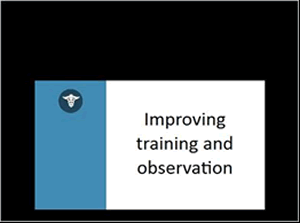Nurse Champions
Nurses, both as bedside staff and as unit leaders, create the care environment. They set standards for practice, behavior, and education. Changing the culture and generating practice change needs to come from within.
Enter the role of nurse champion, who can be instrumental in changing the culture and shaking up the status quo. Their leadership can improve communication and training efforts.
Over 72 percent of the nurses surveyed reported having an effective nurse champion in the pursuit of CAUTI reduction. “Champion” is a word often thrown around, sometimes with no definition as to what the role entails and what the characteristics of an effective nurse champion are.
The nurse champion is recognized as an expert on the issue. He or she is the person to whom the staff goes for questions related to practice, research, and protocols.
The nurse champion is informed on all current research and knows how it is applied to practice. He or she knows what the real-life obstacles are to implementation and how they can be overcome. This results from networking with others in similar positions at other facilities.
Enthusiasm is what will drive the practice change. Unless there is a willingness among the staff to follow a new protocol, all efforts will be useless. A champion who does not have a clear dedication to the cause will never be successful.
Above all, the nurse champion is a patient advocate who knows that the motivation for outcome of any project is improved patient care, and that all decisions are based on that premise.
The nurse champion may also—
- Review for appropriate insertion criteria and indications for removal prior to transfer.
- Review orders and indications.
- Communicate information to staff.
- Provide real-time assessment of technique.
- Support and normalize practice change.
Slide 105

Nurse champion
Image: Photo of a nurse.
Slide 106
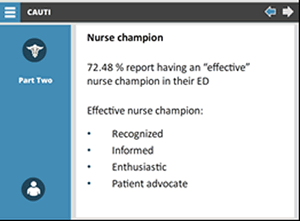
Nurse champion
72.48% report having an "effective" nurse champion in their ED.
Effective nurse champion:
- Recognized
- Informed
- Enthusiastic
- Patient advocate.
Slide 107
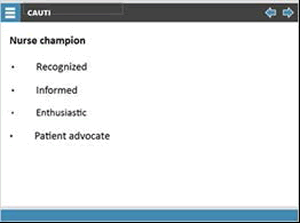
Nurse champion
- Recognized
- Informed
- Enthusiastic
- Patient advocate.
Slide 108
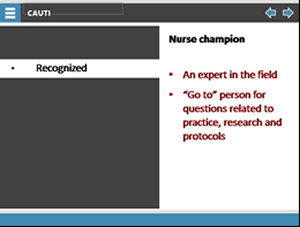
Nurse champion
- Recognized:
- An expert in the field
- "Go to" person for questions related to practice, research, and protocols
Slide 109
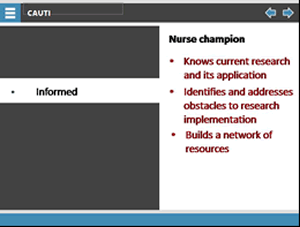
Nurse champion
- Informed:
- Knows current research and its application
- Identifies and addresses obstacles to research implementation
- Builds a network of resources
Slide 110
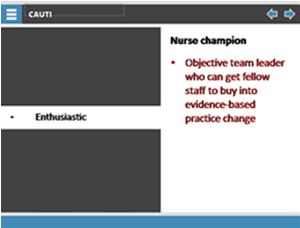
Nurse champion
- Enthusiastic:
- Objective team leader who can get fellow staff to buy into evidence-based practice change
Slide 111
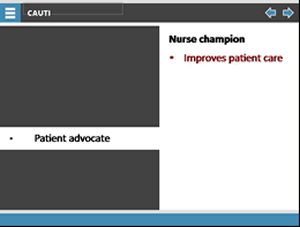
Nurse champion
- Patient advocate:
- Improves patient care
Slide 112
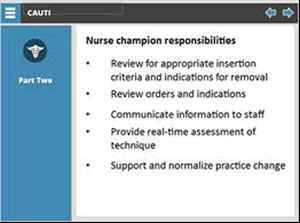
Nurse champion responsibilities
- Review for appropriate insertion criteria and indications for removal
- Review orders and indications
- Communicate information to staff
- Provide real-time assessment of technique
- Support and normalize practice change
Slide 113
Improved training and observation
Changes in Training
We have already made the argument for sterile urinary catheter placement to be considered high risk and the need for competency periodically demonstrated. We have also addressed the benefit of two-person insertion procedures to promote the practice of sterile technique.
But how should we train nurses in sterile urinary catheter insertion? While lecture and simulation may promote comfort in identifying sterile fields and teach the steps to a sterile insertion, documented demonstration with actual patients is a better confirmation of competency. This skill needs to be observed, evaluated, and documented systematically, not treated as a formality or an annual check off. Although personnel who insert catheters are almost exclusively nurses, this training should extend to others who perform the skill, including medical students, residents, and patient care technicians.
Slide 114
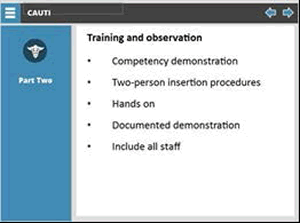
Training and observation
- Competency demonstration
- Two-person insertion procedures
- Hands on
- Documented demonstration
- Include all staff
This quote represents a response by a focus group member regarding barriers and CAUTI reduction and catheter insertion.
Slide 115
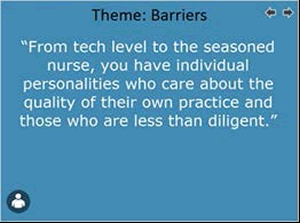
Theme: Barriers
"From tech level to the seasoned nurse, you have individual personalities who care about the quality of thier own practice and those who are less than diligent."
Slide 116
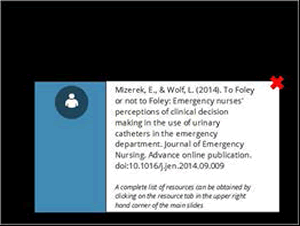
Mizerek E, Wolf L. (2014) To Foley or not to Foley: Emergency nurses' perceptions of clinical decision making in the use of urinary catheters in the emergency department. Journal of Emergency Nursing. Advance online publication. 2014.
A complete list of resources can be obtained by clicking on the resource tab in the upper right hand corner of the main slides.
Slide 117
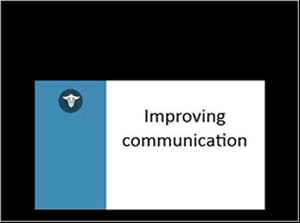
Improving communication
Communication
Nurse-to-nurse communication often centers around handoffs, either to the next shift, relief nurse, or admitting nurse on the inpatient unit. This communication assures continuity of care.
Discussion about the need for a catheter is generally between the nurse and physician or provider, covering the risks and benefits to the individual patient and indications for continuing use or removal. Much of this communication is verbal, but should include collaboration on assuring that an order, with rationale, is entered into the medical record.
Communication with the entire team covers all of that and more. This communication includes confirming the patient care technicians are aware of care required for safe catheter usage, knowing what surgical interventions may be planned, and what might be needed for other departments or diagnostic testing. Finally, but maybe most important, is the communication with the patient and family to determine what they know and expect.
Slide 118
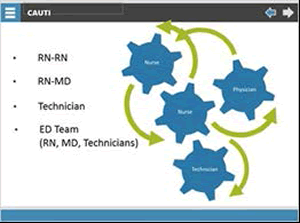
Graphic of four interlocking gears labeled nurse, nurse, physician, technician. Bulleted list: RN-RN, RN-MD, Technician, ED Team (RN, MD, Technicians).
Slide 119
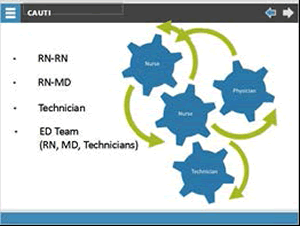
Graphic of four interlocking gears labeled nurse, nurse, physician, technician. Bulleted list: RN-RN, RN-MD, Technician, ED Team (RN, MD, Technicians)
Slide 120
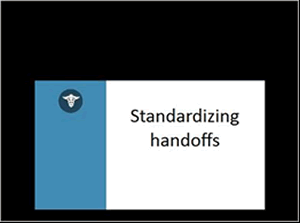
Standardizing handoffs
Handoffs and the Joint Commission
The Joint Commission definition of standardized handoff communication is “a process in which information about patient/client/resident care is communicated in a consistent manner” from one health care provider to another. The handoff facilitates continuity of care within the ED, as well as a smooth transition to an inpatient unit or another facility.
Slide 121
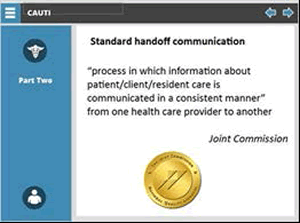
Standard handoff communication
"process in which information about patient/client/resident care is communicated in a consistent mannter" from one health care provider to another.
--Joint Commission.
Slide 122
![The Joint Commission. National Patient Safety Goals. Handoff Communications, Standardized Approach [NPSG 02.05.01] A complete list of resources can be obtained by clicking on the resource tab in the upper right hand corner of the main slides.](/sites/default/files/wysiwyg/professionals/quality-patient-safety/hais/cauti-tools/ena-presentation/enaslide122.gif)
The Joint Commission. (2008) National Patient Safety Goals. Handoff Communications, Standardized Approach [NPSG 02.05.01]
A complete list of resources can be obtained by clicking on the resource tab in the upper right hand corner of the main slides.
What is included in a successful handoff?
- Patient presentation: What was the chief complaint?
- Diagnostic workup: What additional information was obtained from laboratory testing, imaging, and clinical examination?
- Results and diagnosis: How was a diagnosis determined based on those results?
- Treatments/interventions in the ED: What interventions were started, completed, and reassessed? Did this change the plan for ongoing care?
- Current status: Is the original chief complaint still relevant or have other priorities emerged?
- Where they are going? What is the disposition or plan?
Slide 123
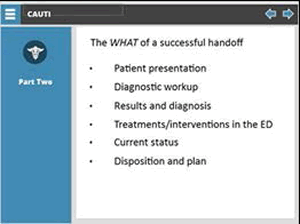
The WHAT of a success handoff
- Patient presentation
- Diagnostic workup
- Results and diagnosis
- Treatments/interventions in the ED
- Current status
- Disposition and plan
Contextualizing the Plan or Putting it Into Action
In the case of congestive heart failure (CHF) or urinary retention—
- Once treatment has begun and a reassessment completed, is the indication for the catheter still applicable? For example, once the patient with CHF has been diuresed, has urinary output been adequate? Is the work of breathing decreased and shortness of breath improved? Are the breath sounds clearer? All of this information is included in a good handoff to promote collaboration on the decision to retain or remove the catheter.
Slide 124
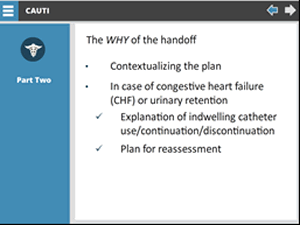
The WHY of the handoff
- Contextualizing the plan
- In case of congestive heart failure (CHF) or urinary retention:
- Explanation of indwelling catheter use/continuation/discontinuation
- Plan for reassessment.
Report on a Bad Day on the Floor (sample handoff)
ED RN: Hey there! Hope your day is going better than mine.
M/S RN: Worst. Day. Ever.
ED RN: Sorry. Listen, let me tell you about Davy Jones. He’s a 65-year-old man with a history of CHF and AFib. He came into the ER with a complaint of shortness of breath, and we found him to have crackles 2/3 of the way up and an O2 sat of 88 percent. His respiratory rate was 24. He was working.
M/S RN: Yeah. Lotta that going around.
ED RN: His chest X-ray was fluffy, and his BNP was 2800, so we gave him 160 of furosemide to dry him out a little.
M/S RN: How much did he put out?
ED RN: Two thousand mLs of clear pale urine. His crackles are now only at the bases, which is baseline for him. His SaO2 is 96 percent, and his respiratory rate has dropped from 24 to 14.
M/S RN: Okay. Anything else? What’s in his Foley now?
ED RN: He doesn’t have a Foley. We removed it once he improved. He’s using a urinal now, and has put out an additional 500 mLs for me.
M/S RN: Really?
ED RN: He didn’t need a catheter. He could use a urinal, we measured his output, and he can ambulate by himself to the bathroom now that he can breathe.
M/S RN: I get that it’s better for him, but I’m glad to hear he can ambulate. I’ve got six patients today, and I’m in charge here. I just can’t toilet another one.
ED RN: Are you doing the CAUTI reduction thing too? I know we just started trying to use fewer caths and looking at taking them out. We’ve never done that, but it seems to make sense. Are you looking at cath use up there too?
M/S RN: We are. It sometimes seems like more work, but we’re finding it to work out better. So, if he’s going to need any extra help toileting, let me see about switching him to a nurse with a smaller assignment. I have someone who’s got four patients and an upcoming discharge. I’ll pass along your report and you can send him up when you’re ready.
Slide 125
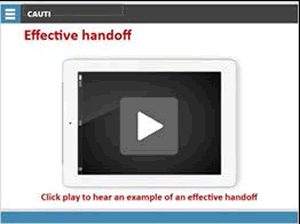
Effective handoff
Image of a large white arrow.
Click play to hear an example of an effective handoff.
Slide 126
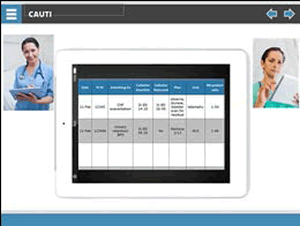
Two photos of a nurse taking notes and a screen shot of a handoff sheet.
Slide 127
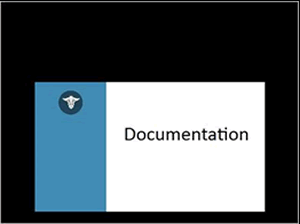
Documentation
Organized Data
Collecting organized data will help turn the concept of “your problem” and “my problem” into “our problem.” All parties have a stake in the data collection as it tracks the workload objectively, and this may help alleviate conflict and contribute to changing the culture of the institution. Good data ideally makes for easier translation of plans into practice.
Slide 128
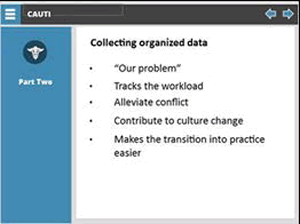
Collecting organized data
- "Our problem"
- Tracks the workload
- Alleviate conflict
- Contribute to culture change
- Makes the transition into practice easier.
Standardized Handoffs
A well-constructed handoff can be useful as a data collection tool as you track efforts related to CAUTI reduction. Information in this tool can include:
- The number of catheters removed in the ED prior to admission
- The patient load for the inpatient nurse who may be receiving a patient with an indwelling catheter
- The number of patients admitted with an indwelling catheter in place
- The number of patients admitted without catheters
- Any anticipated need for additional staff for non-catheterized patients for more frequent linen changes, toileting needs, or documentation of intake and output
Slide 129
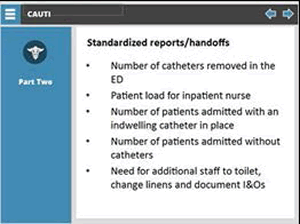
Standardized reports/handoffs
- Number of catheters removed in the ED
- Patient load for inpatient nurse
- Number of patients admitted with an indwelling catheter in place
- Number of patients admitted without catheters
- Need for additional staff to toilet, change lines, and document I&Os
Sample Handoff
This is a sample handoff sheet that can easily collect data for your CAUTI reduction plan, whether this data is for the national initiative or your own quality improvement project. Recommended data include patient identifier, admitting diagnosis, location, date and time of catheter insertion, and of removal, if applicable. Also include the rationale for continued use or plan for removal. The nurse-to-patient ratio and receiving unit may help determine staffing needs.
Slide 130
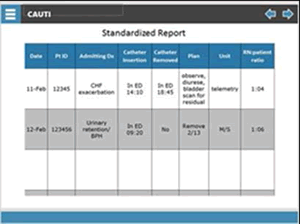
Standardized Report
Screen shot of sample handoff sheet showing patient identifier, admitting diagnosis, location, date and time of catheter insertion, and of removal.
Questions
Consider each of the following questions and how it pertains to you and your institution.
- How are data being collected?
- Is there a handoff tool for reporting to the inpatient nurse?
- Is it well utilized by the emergency nurse?
- Has the handoff tool enhanced communication with the inpatient staff? If so, how?
- Has it improved reporting of data surrounding CAUTI reduction?
Finally, if it has not produced improvement, what needs to happen in your institution to make this practice change? What are the barriers? What solutions might exist? How can you gather data to support your efforts?
Slide 131
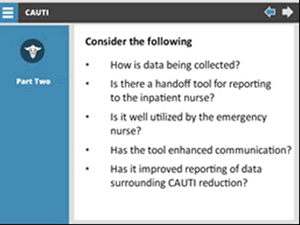
Consider the following
- How is data being collected?
- Is there a handoff tool for reporting to the inpatient nurse?
- Is it well utilized by the emergency nurse?
- Has the tool enhanced communication?
- Has it improved reporting of data surrounding CAUTI reduction?
Slide 132
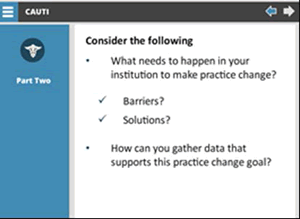
Consider the following
- What needs to happen in your institution to make practice change?
- Barriers?
- Solutions?
- How can you gather data that supports this practice change goal?
Hard Data
We need to have measurable outcomes to effect change. This involves collecting both hard and soft data. Hard data include—
- The number of catheters placed in the ED
- The observed use of sterile technique during the catheter insertion procedure
- The observed consistent use of two-person catheter insertion
- The existence and acceptance of nurse-driven protocols to support the decision-making process for catheter placement and removal
- The number of indwelling urinary catheters removed before patients transfer from the ED to the inpatient units
- The duration of catheterization
- The number of documented catheter-associated infections
Slide 133
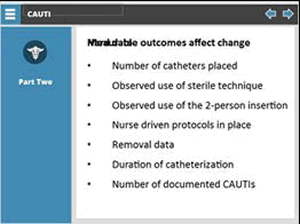
Measurable outcomes affect change
- Number of catheters placed
- Observed use of sterile technique
- Observed use of the two-person insertion
Nurse driven protocols in place - Removal data
- Duration of catheterization
- Number of documented CAUTIs.
Soft Data
Soft data is a little more difficult to capture as it is more subjective, but it is equally crucial in effecting practice change. Here, we measured styles and practices in communications between nurses, nurses and physicians, and nurses and the entire team. This led to the development of a handoff tool to facilitate some of this communication. Other aspects included in the soft data were competence and confidence in the skills and process of decision making and how they related to reducing catheter usage and ensuring timely catheter removal.
Slide 134
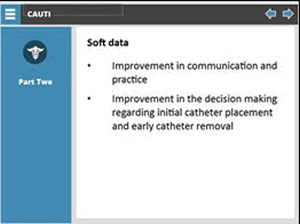
Soft data
- Improvement in communication and practice
- Improvement in the decision making regarding initial catheter placement and early catheter removal.
Data Drive Change
Collaboratively developed protocols and standardized documentation for communications between emergency and inpatient nurses help to remove assumptions from the decision-making process. Both staffs share the goal of reducing the utilization of urinary catheters with their associated infections. Having data to present to administrators can also support the nurse or nurse champion in advocating for more resources and personnel.
Slide 135
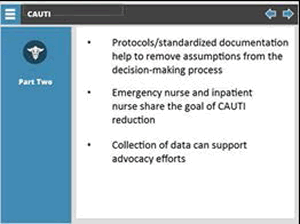
- Protocols/standardized documentation help to remove assumptions from the decision making process.
- Emergency nurse and inpatient nurse share the goal of CAUTI reduction.
- Collection of data can support advocacy efforts.




